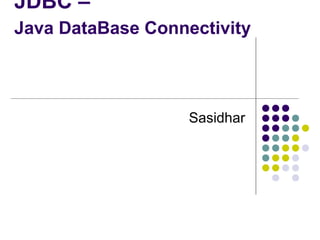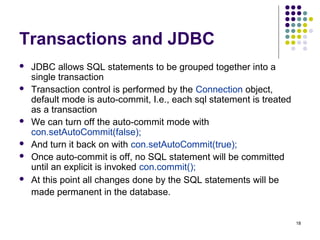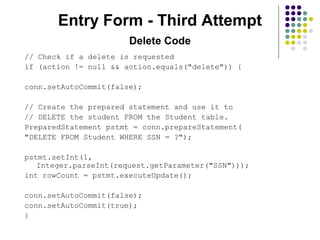JDBC provides an API for accessing databases from Java that simplifies development, supports metadata access, and allows connection pooling. It includes interfaces for application writers and driver writers, with popular drivers available for databases like Oracle, MySQL, and SQL Server. JDBC drivers can be Type 1 (JDBC-ODBC bridge), Type 2 (partial JDBC), Type 3 (pure Java for middleware), or Type 4 (direct connection).




















![21
Sample program
import java.sql.*;
class Test {
public static void main(String[] args) {
try {
Class.forName("sun.jdbc.odbc.JdbcOdbcDriver"); //dynamic loading of driver
String filename = "c:/db1.mdb"; //Location of an Access database
String database = "jdbc:odbc:Driver={Microsoft Access Driver (*.mdb)};DBQ=";
database+= filename.trim() + ";DriverID=22;READONLY=true}"; //add on to end
Connection con = DriverManager.getConnection( database ,"","");
Statement s = con.createStatement();
s.execute("create table TEST12345 ( firstcolumn integer )");
s.execute("insert into TEST12345 values(1)");
s.execute("select firstcolumn from TEST12345");](https://image.slidesharecdn.com/jdbc-sasidhar-150416041510-conversion-gate01/85/Jdbc-sasidhar-21-320.jpg)





![27
Metadata from DB - example
…
Connection con = …. ;
DatabaseMetaData dbmd = con.getMetaData();
String catalog = null;
String schema = null;
String table = “sys%”;
String[ ] types = null;
ResultSet rs =
dbmd.getTables(catalog , schema , table , types );
…](https://image.slidesharecdn.com/jdbc-sasidhar-150416041510-conversion-gate01/85/Jdbc-sasidhar-27-320.jpg)








![Prepared Statement Example
PreparedStatement updateSales;
String updateString = "update COFFEES " +
"set SALES = ? where COF_NAME like ?";
updateSales = con.prepareStatement(updateString);
int [] salesForWeek = {175, 150, 60, 155, 90};
String [] coffees = {"Colombian", "French_Roast",
"Espresso","Colombian_Decaf","French_Roast_Decaf"};
int len = coffees.length;
for(int i = 0; i < len; i++) {
updateSales.setInt(1, salesForWeek[i]);
updateSales.setString(2, coffees[i]);
updateSales.executeUpdate();
}](https://image.slidesharecdn.com/jdbc-sasidhar-150416041510-conversion-gate01/85/Jdbc-sasidhar-36-320.jpg)







![import java.sql.*;
class JdbcTest {
public static void main (String args []) throws SQLException {
// Load Oracle driver
DriverManager.registerDriver (new
oracle.jdbc.driver.OracleDriver());
// Connect to the local database
Connection conn = DriverManager.getConnection
("jdbc:oracle:thin:@myhost:1521:ORCL","scott", "tiger");
JDBC](https://image.slidesharecdn.com/jdbc-sasidhar-150416041510-conversion-gate01/85/Jdbc-sasidhar-44-320.jpg)




















